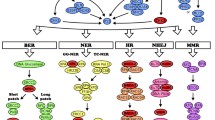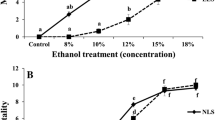Abstract
Aging is a biological process associated with gradual loss of function caused by cellular and molecular damages ultimately leading to mortality. Free radicals are implicated in oxidative damage which affects the longevity of organisms. Natural cellular defenses involving antioxidant enzymes delay or prevent oxidative damage and, therefore, influence the aging process and longevity has been shown in many species including Drosophila. We and others have shown that oxidative resistance is an important mechanism in the aging process in Drosophila. Therefore, we hypothesized that repressing endogenous antioxidant defenses shortens longevity in Drosophila. To study the influence of natural defense mechanisms against oxidative stress in aging, we have investigated the effect of genetic repression of the antioxidant enzymes, superoxide dismutase (SOD) and catalase (CAT), on longevity in Drosophila using transgenic RNAi flies and in vivo inhibition of the enzymes with chemical inhibitors. RNAi lines of Drosophila viz., UAS-sod1-IR and UAS-cat-IR, are driven ubiquitously using Act5C-Gal4 and Tubulin-Gal4 to achieve the suppression of SOD1 and CAT activities, respectively. We show that genetic repression of SOD1 and CAT by RNAi in transgenic flies led to drastically reduced longevity (SOD1, 77%; CAT, 83%), presenting the evidence for the role of endogenous antioxidant defenses in lifespan extension in Drosophila. Further, our study shows that the enzyme inhibitors, diethyldithiocarbamate and 3-amino-1,2,4-triazole, although lower the enzyme activities in vivo in flies, but did not affect longevity, which could be attributed to the factors such as bioavailability and metabolism of the inhibitors and adaptive mechanisms involving de novo synthesis of the enzymes. Our study of genetic repression using transgenic RNAi provides experimental evidence that extended longevity is associated with endogenous antioxidant defenses and aging is correlated with oxidative stress resistance.





Similar content being viewed by others
Data availability
All data generated or analyzed during this study are included in this published article (and its supplementary information files).
References
Aebi H (1984) Catalase in vitro. Methods Enzymol 05:121–125
Alic N, Hoddinott MP, Foley A, Slack C, Piper MDW, Partridge L (2012) Detrimental effects of RNAi: a cautionary note on its use in Drosophila ageing studies. PLoS ONE 7:e45367
Ames BN, Shigenaga MK, Hagen TM (1993) Oxidants, antioxidants, and the degenerative diseases of aging. Proc Natl Acad Sci USA 90:7915–7922
Archer CR, Sakaluk SK, Selman C, Royle NJ, Hunt J (2013) Oxidative stress and the evolution of sex differences in lifespan and ageing in the decorated cricket, Gryllodes sigillatus. Evolution 67:620–634
Arking R (2001) Gene expression and regulation in the extended longevity phenotypes of Drosophila. Ann NY Acad Sci 928:157–167
Arking R, Force AG, Dudas SP, Buck S, Baker GT III (1996) Factors contributing to the plasticity of the extended longevity phenotypes of Drosophila. Exp Gerontol 31:623–643
Arking R, Burde V, Graves K, Hari R, Feldman E, Zeevi A, Soliman S, Saraiya A, Buck S, Vettraino J, Sathrasala K (2000) Identical longevity phenotypes are characterized by different patterns of gene expression and oxidative damage. Exp Gerontol 35:353–373
Arking R, Buck S, Hwangbo D-S, Lane M (2002) Metabolic alterations and shift in energy allocations are corequisites for the expression of extended longevity genes in Drosophila. Ann NY Acad Sci 959:251–262
Arnelle DR, Day BJ, Stamler JS (1997) Diethyl dithiocarbamate-induced decomposition of S-nitrosothiols. Nitric Oxide 1:56–64
Aversa R, Petrescu RVV, Apicella A, Petrescu FIT (2016) One can slow down the aging through antioxidants. Am J Eng Appl Sci 9(4):1112–1126
Beckman KB, Ames BN (1998) The free radical theory of aging matures. Physiol Rev 78(2):547–581
Bewley G, Laurie-Ahlberg CC (1984) Genetic variation affecting the expression of catalase in Drosophila melanogaster: correlations with rates of enzyme synthesis and degradation. Genetics 106:435–448
Blackney MJ, Cox R, Shepherd D, Parker JD (2014) Cloning and expression analysis of Drosophila extracellular Cu Zn superoxide dismutase. Biosci Rep 34:e00164
Buck SA, Arking R (2002) Metabolic alterations in genetically selected Drosophila strains with different longevities. J Am Aging Assoc 24:151–162
Clement MV, Luo L (2020) Organismal aging and oxidants beyond macromolecules damage. Proteomics 20(5–6):e1800400
Deepashree S, Haddadi M, Ramesh SR, Shivanandappa T (2012) Isolation of a long lifespan strain of Drosophila melanogaster. Drosoph Inf Serv 95:101–103
Deepashree S, Shivanandappa T, Ramesh SR (2017) Life history traits of an extended longevity phenotype of Drosophila melanogaster. Curr Aging Sci 10:224–238
Deepashree S, Shivanandappa T, Ramesh SR (2018) Is longevity a heritable trait? Evidence for non-genomic influence from an extended longevity phenotype of Drosophila melanogaster. Curr Aging Sci 11:24–32
Deepashree S, Niveditha S, Shivanandappa T, Ramesh SR (2019) Oxidative stress resistance as a factor in aging: evidence from an extended longevity phenotype of Drosophila melanogaster. Biogerontology 20:497–513
Dudas SP, Arking R (1995) Coordinate upregulation of the antioxidant gene activities is associated with the delayed onset of senescence in a long lived strain of Drosophila. J Gerontol Biol Sci 50A:B117–B127
Durusoy M, Diril N, Bozcuk AN (1995) Age-related activity of catalase in different genotypes of Drosophila melanogaster. Exp Gerontol 30:77–86
Gems D, Doonan R (2009) Antioxidant defense and aging in C. elegans: is the oxidative damage theory of aging wrong? Cell Cycle 8(11):1681–1687
Guarante L, Kenyon C (2000) Genetic pathways that regulate ageing in model organisms. Nature 408:255–262
Harman D (1956) Aging: a theory based on free radical and radiation chemistry. J Gerontol 11(3):298–300
He L, He T, Farrar S, Ji L, Liu T, Ma X (2017) Antioxidants maintain cellular redox homeostasis by elimination of reactive oxygen species. Cell Physiol Biochem 44(2):532–553
Ikeno Y, Flores LC (2020) Oxidative stress in aging: stayin’ alive? Aging Pathobiol Ther 2(2):62–63
Jones DP (2015) Redox theory of aging. Redox Biol 5:71–79
Junqueira VBC, Barros SBM, Chan SS, Rodrigues L, Giavarotti L, Abud RL, Deucher GP (2004) Aging and oxidative stress. Mol Aspects Med 25:5–16
Kato R (1967) Effect of administration of 3-aminotriazole on the activity of microsomal drug-metabolizing enzyme systems of rat liver. Jpn J Pharmacol 17:56–63
Kirby K, Hu J, Hilliker AJ, Phillips JP (2002) RNA interference-mediated silencing of Sod2 in Drosophila leads to early adult-onset mortality and elevated endogenous oxidative stress. Proc Natl Acad Sci USA 99:16162–16167
Kuether K, Arking R (1999) Drosophila selected for extended longevity are more sensitive to heat shock. Age 22:175–180
Le Bourg E (2001) Oxidative stress, aging and longevity in Drosophila melanogaster. FEBS Lett 498:183–186
Lints FA, Soliman HM (1988) Drosophila as a model organism for ageing studies. Blackie and Son, Ltd., Glasgow
Lowry OH, Rosebrough NJ, Farr AL, Randall RJ (1951) Protein measurement with the folin phenol reagent. J Biol Chem 193:265–275
Lushchak VI (2014) Free radicals, reactive oxygen species, oxidative stress and its classification. Chem Biol Interact 224:164–175
Lushchak VI (2021) Interplay between bioenergetics and oxidative stress at normal brain aging. Aging as a result of increasing disbalance in the system oxidative stress-energy provision. Pflugers Arch 473(5):713–722
Lushchak VI, Bagnyukova TV, Lushchak OV, Storey JM, Storey KB (2007) Diethyldithiocarbamate injection induces transient oxidative stress in goldfish tissues. Chem Biol Interact 170(1):1–8
Margoliash E, Novogrodsky A, Schejter A (1959) Irreversible reaction of 3-amino-1:2:4-triazole and related inhibitors with the protein of catalase. Biochem J 74:339–348
Marklund SL, Marklund G (1974) Involvement of the superoxide anion radical in the autoxidation of pyrogallol and a convenient assay for superoxide dismutase. Eur J Biochem 47:469–474
Miquel J, Economos AC, Fleming J, Johnson JE Jr (1980) Mitochondrial role in cell aging. Exp Gerontol 15(6):575–591
Mockett RJ, Bayne ACV, Kwong LK, Orr WC, Sohal RS (2003) Ectopic expression of catalase in Drosophila Mitochondria increases stress resistance but not longevity. Free Radic Biol Med 34:207–217
Negroni MA, Foitzik S, Feldmeyer B (2019) Long-lived Temnothorax ant queens switch from investment in immunity to antioxidant production with age. Sci Rep 9(1):7270
Niveditha S, Deepashree S, Ramesh SR, Shivanandappa T (2017) Sex differences in oxidative stress resistance in relation to longevity in Drosophila melanogaster. J Comp Physiol B 187:899–909
Orr WC, Sohal RS (1992) The effects of catalase gene overexpression on life span and resistance to oxidative stress in transgenic Drosophila melanogaster. Arch Biochem Biophys 297:35–41
Orr WC, Sohal RS (1993) Effects of Cu–Zn superoxide dismutase overexpression on life span and resistance to oxidative stress in transgenic Drosophila melanogaster. Arch Biochem Biophys 301:34–40
Orr WC, Sohal RS (1994) Extension of life span by overexpression of superoxide dismutase and catalase in Drosophila melanogaster. Science 263:1128–1130
Partridge L, Fowler K (1992) Direct and correlated responses to selection on age at reproduction in Drosophila melanogaster. Evolution 46:76–91
Phillips JP, Campbell SD, Michaud D, Charbonneau M, Hilliker AJ (1989) A null mutation of cSOD in Drosophila confers hypersensitivity to paraquat and reduced longevity. Proc Natl Acad Sci USA 86:2761–2765
Phillips JP, Tainer JA, Getzoff ED, Boulianne GL, Kirby K, Hilliker AJ (1995) Subunit-destabilizing mutations in Drosophila copper/zinc superoxide dismutase: neuropathology and a model of dimer dysequilibrium. Proc Natl Acad Sci USA 92:8574–8578
Phillips JP, Parkes TL, Hilliker AJ (2000) Targeted neuronal gene expression and longevity in Drosophila. Exp Gerontol 35:1157–1164
Rose MR (1984) Laboratory evolution of postponed senescence in Drosophila melanogaster. Evolution 38:1004–1010
Ruiz-Ojeda FJ, Gomez-Llorente C, Aguilera CM, Gil A, Rupérez AI (2016) Impact of 3-amino-1,2,4-triazole (3-AT)-derived increase in hydrogen peroxide levels on inflammation and metabolism in human differentiated adipocytes. PLoS ONE 11(3):e0152550
Santos-Sánchez NF, Salas-Coronado R, Villanueva-Cañongo C, Hernández-Carlos B (2019) Antioxidant compounds and their antioxidant mechanism. Antioxidants. IntechOpen
Sohal RS, Farmer KJ, Allen RG, Ragland SS (1984) Effects of diethyldithiocarbamate on life span, metabolic rate, superoxide dismutase, catalase, inorganic peroxides and glutathione in the adult male housefly, Musca domestica. Mech Ageing Dev 24:175–183
Speakman JR, Selman C (2011) The free-radical damage theory: accumulating evidence against a simple link of oxidative stress to ageing and lifespan. BioEssays 33(4):255–259
Sun J, Tower J (1999) FLP recombinase-mediated induction of Cu/Zn-superoxide dismutase transgene expression can extend the life span of adult Drosophila melanogaster flies. Mol Cell Biol 19:216–228
Tasaki E, Kobayashi K, Matsuura K, Iuchi Y (2017) An efficient antioxidant system in a long-lived termite queen. PLoS ONE 12(1):e0167412
Tyler R, Brar H, Singh M, Latorre A, Graves JL, Mueller LD, Rose MR, Ayala FJ (1993) The effect of superoxide dismutase alleles on aging in Drosophila. Genetica 91:143–149
Viña J (2019) The free radical theory of frailty: mechanisms and opportunities for interventions to promote successful aging. Free Radic Biol Med 134:690–694
Warner HR (1994) Superoxide dismutase, aging and degenerative disease. Free Radic Biol Med 17:249–258
Warraich UE, Hussain F, Kayani HUR (2020) Aging–oxidative stress, antioxidants and computational modeling. Heliyon 6(5):e04107
Wit J, Sarup P, Lupsa N, Malte H, Frydenberg J, Loeschcke V (2013) Longevity for free? Increased reproduction with limited trade-offs in Drosophila melanogaster selected for increased lifespan. Exp Gerontol 48:349–357
Xiong CX (2010) The metal ion content of Drosophila melanogaster expressing copper-zinc superoxide dismutase (CuZnSOD). Thesis submitted to College of Science and Mathematics, California State University, Fresno
Yang J, Dong S, Jiang Q, Kuang T, Huang W, Yang J (2013) Changes in expression of manganese superoxide dismutase, copper and zinc superoxide dismutase and catalase in Brachionus calyciflorus during the aging process. PLoS ONE 8:e57186
Ziada AS, Smith MR, Côté HCF (2020) Updating the free radical theory of aging. Front Cell Dev Biol 8:575645
Acknowledgements
The first author thanks the Department of Science and Technology, Government of India, for the financial support under the INSPIRE Program. The authors thank the Chairpersons of the Department of Studies in Zoology for the facilities.
Author information
Authors and Affiliations
Corresponding author
Additional information
Communicated by H.V. Carey.
Publisher's Note
Springer Nature remains neutral with regard to jurisdictional claims in published maps and institutional affiliations.
Supplementary Information
Below is the link to the electronic supplementary material.
Rights and permissions
About this article
Cite this article
Deepashree, S., Shivanandappa, T. & Ramesh, S.R. Genetic repression of the antioxidant enzymes reduces the lifespan in Drosophila melanogaster. J Comp Physiol B 192, 1–13 (2022). https://doi.org/10.1007/s00360-021-01412-7
Received:
Revised:
Accepted:
Published:
Issue Date:
DOI: https://doi.org/10.1007/s00360-021-01412-7




